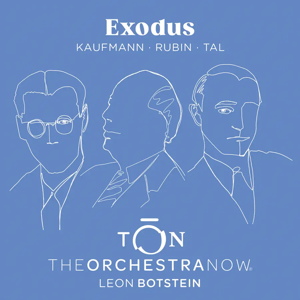
Exodus
Josef Tal (1910-2008)
Exodus (1946/1947)
Walter Kaufmann (1907-1984)
Indian Symphony (1943)
Marcel Rubin (1905-1995)
Symphony No 4 ‘Dies irae’ (1943-1945, rev. 1972)
Noam Heinz (baritone), The Orchestra Now/Leon Botstein
rec. 2023, Fisher Center, Bard College, Annandale-on-Hudson, USA
Texts and translations provided
Reviewed as lossless download
Avie AV2713 [75]
The generations of Jewish European composers affected by the events before, during and after World War II are beginning to receive some attention, most notably the Music in Exile series on Chandos, which numbers at least eight recordings so far. The three composers featured here – the Polish-born Tal, Bohemian Kaufmann and Austrian Rubin – were among those who chose to leave their homelands while they could.
Josef Tal went to Palestine, and became one of the founders of Israeli classical music. Exodus is based on excerpts from the Old Testament Books of Exodus and Psalms (Tal’s father was a rabbi, but he himself was not religious), and was written in the same year of the events portrayed in Leon Uris’s book of the same name. The writing for the baritone is quite declamatory, and hard going at times (as is, of course, the story that is being told), but I did very much enjoy the writing for the orchestra, which in its lighter textures is a contrast to the vocal writing. The work begins with a grim march (Servitude) and finishes with a wild dance (Miriam’s Dance). Tal’s style is the most modernist of the three composers here – he was an adherent of Schoenberg – but there isn’t much in the way of dissonance, let alone atonality, here.
Walter Kaufmann went even further east than Tal, his first port of call was Bombay (now Mumbai). He spent twelve years in India, and whilst there, wrote the theme for All-India Radio’s morning broadcast that is used to this day. He also taught Zubin Mehta. When the work began, I immediately thought of cinematic depictions of the American West, only to find the booklet notes telling me that much of the thematic content of the work is based on an Indian raga. The first movement has a motoric drive throughout and a repetitiveness, which could become dull if Kaufmann fell into the trap so often encountered by lesser composers of over-extending his material. But he doesn’t: the whole symphony is less than eighteen minutes. The calm slow movement has beautiful writing for the woodwinds and solo viola and serves as a contrast to the vibrant and energetic finale. Earlier this year, Jonathan Woolf reviewed a cpo release of Kaufmann’s orchestral music, which also included the Indian Symphony (Avie must have cursed their bad luck in being pipped at the post). He too had a sense of the American West, alluding to a hoedown in the final movement. I have no idea whether in the midst of the war, Kaufmann can have heard Copland’s Rodeo, written the year before the Indian Symphony. It seems unlikely but there is a definite connection. I think it is a marvellous work, and I will be exploring the other recordings of Kaufmann’s music, including his entry in the Chandos series (review).
Unlike the other two, Marcel Rubin went west, spending the war years in Mexico City. He had been taught by Milhaud and Schmidt, but this work has little of those influences. I hear strong echoes of Shostakovich throughout the work, but one should bear in mind that Rubin wrote this at the same time as the Russian master was composing his own war symphonies. The original version had four movements, and was titled War and Peace, the finale a celebration of peace. In 1972, Rubin, feeling that there had been not enough to celebrate in the years following the war, modified the third movement Pastorale, deleted the fourth entirely and gave the work a new title. It is that version that is performed here. The first and second movements, whilst impressive, do suffer from a lack of concision at over fifteen and twelve minutes, respectively. Yes, Shostakovich often wrote very lengthy movements, but history remembers him, and not Rubin, as one of the great composers. There are episodes where not a lot happens and others where what is happening is unmemorable. In between there are some exciting and stirring sections. The six minute Pastorale that closes the work is brooding rather than pastoral, and illustrates the positive aspects of brevity. The only other recording of the work is also conducted by Leon Botstein, from 2013 with the American Symphony Orchestra (I haven’t heard it).
The Orchestra Now was founded by Leon Botstein in 2015, and is the performance arm of graduate programs in Orchestral Studies at Bard College in New York state. The students play this unfamiliar music with great skill and dedication. The booklet notes are as good as one would ever find, and I commend Avie for mentioning another label’s recording – the Kaufmann on Chandos (interestingly the notes suggest that there is also a 2024 Chandos release of his orchestral music which I can find no reference to anywhere – I wonder if it is actually the cpo release). The sound quality is a little congested, but still perfectly adequate.
Avie have served up a real winner here. Yes, I have a few reservations, but they didn’t stop me greatly enjoying these three works.
David Barker
Buying this recording via a link below generates revenue for MWI, which helps the site remain free.




















